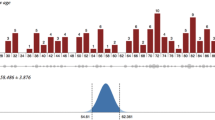Abstract
The rigid spine syndrome (RSS) is not a recognized cause of dysphagia. The “vacuolar variant” of RSS causes mild, generalized, and slowly progressive weakness. Respiratory evaluation detected severe restrictive chest wall defect and significant respiratory muscle weakness. We identified nine patients at our Neuromuscular Clinic over a period of years. The aim of this evaluation was to ascertain whether pharyngoesophageal dysfunction caused cough (2/9), intermittent oropharyngeal dysphagia (4/9), and aspiration pneumonia (3/9). Pharyngeal and esophageal functions were evaluated separately by conventional cineradiography and intraluminal esophageal manometry over a one-year study period. An age- and gender-matched volunteer group without swallowing complaints partook in the manometric component of the study. There were seven male and two female patients. The mean age of patients was 19.1 years (17.8 years for controls), and the age range was 11–36 years (13–32 years for controls). The mean disease duration was 17.2 years (range = 8–31 years). Patients were commonly underweight (7/9). Cineradiology detected abnormal swallow physiology of pharyngeal striated muscle (1/9) and of esophageal smooth muscle (2/9). Mean manometric pressures in patients were not significantly different from control data. Manometry detected “nonspecific” contractility abnormalities (3/9) that were not reflected in the mean data. The relative lack of instrumental findings suggested minor upper alimentary tract dysmotility in patients with the RSS. The myopathy that underlies this syndrome likely caused dysfunction of the striated muscle of the pharyngeal constrictors and upper esophageal sphincter. The documented abnormalities of esophageal smooth muscle motility were nonspecific and tenuously associated with the muscle disorder. The incongruity between complaints of intermittent dysphagia and study results was perhaps due to transient pharyngoesophageal dysmotility, altered swallowing mechanics of limited cervical spine mobility, altered swallowing perception after previous intubation/tracheostomy, or a “functional” upper intestinal complaint.
Similar content being viewed by others
References
Banker BQ, Engel AG. The polymyositis and dermatomyositis syndromes. In: Engel AG, Banker BQ, editors. Myology, vol 2. New York: McGraw-Hill; 1996. pp 1385–1422.
Harper PS. Myotonic Dystrophy. Philadelphia: WB Sanders; 1979.
Tome FMS, Fardeau M. Ocular myopathies. In: Engel AG, Banker BQ, editors. Myology, vol 2. New York: McGraw-Hill; 1986. pp 1327–1347.
Stübgen JP. Limb girdle muscular dystrophy: A radiologic and manometric study of the pharynx and esophagus. Dysphagia 1996;11:25–29.
Dubowitz V. Recent advances in neuromuscular disorders. Rheumatol Phys Med 11:126–130, 1971.
Dubowitz V. Rigid spine syndrome: a muscle syndrome in search of a name. Proc R Soc Med 1973;66:219–220.
Vogel P, Goebel HH, Seitz D. Rigid spine syndrome in a girl. J Neurol 1982;228:259–265.
Echenne B, Astruc J, Brunel D, Pages M, Baldet P, Martinazzo G. Congenital muscular dystrophy and rigid spine syndrome. Neuropediatrics 1983;14:97–101.
Van Munster ETL, Joosten EMG, Van Munster-Uijtdehaage MAM, Kruls HJA, Terlaak HJ. The rigid spine syndrome. J Neurol Neurosurg Psychiatry 1986;49:1292–1297.
Poewe W, Willeit H, Sluga E, Mayr U. The rigid spine syndrome. A myopathy of uncertain nosologic position. J Neurol Neurosurg Psychiatry 1985;48:887–893.
Bertini E, Marini R, Sabetta G, Palmieri GP, Spagnoli LG, Vaccario ML, deBarsy T. The spectrum of the so-called rigid spine syndrome: nosologic considerations and report of three female cases. J Neurol 1986;223:248–253.
Lotz BP, Stübgen J-P. The rigid spine syndrome: a vacuolar variant. Muscle Nerve 1993;16:530–536.
Ras JR, van Staden M, Schultz C, Stübgen J-P, Lotz BP, van der Merwe C. Respiratory manifestations of the rigid spine syndrome. Am J Respir Crit Care Med 1994;150:540–546.
Llewellyn-Jones D, Abraham SF. Quetelet index in diagnosis of anorexia nervosa. Br Med J 1984;288:1800.
Mendell JR, Florence J. Manual muscle testing. Muscle Nerve 1990;13(suppl):16–20.
Dodds WJ. Radiology (of the esophagus and esophagogastric region). In: Margulis AR, Burhenne HJ, editors. Alimentary Tract Radiology, vol 1. St. Louis: CV Mosby; 1983. pp 529–603.
Seaman WB. Radiology (of the pharynx). In: Margulis AR, Burhenne HJ, editors. Alimentary Tract Radiology, vol 1. St. Louis: CV Mosby; 1983. pp 491–518.
Richter JE, Wu WC, Johns DN, Blackwell JN, Nelson JL, Castell JA, Castell DO. Esophageal manometry in 95 healthy volunteers. Variability of pressure with age, frequency of “abnormal” contractions. Dig Dis Sci 1987;32:583–592.
Dodds WJ, Hogan WJ, Stef JJ, Miller WN, Lydon SB, Andorfer RC. A rapid pull-through technique for measuring lower oesaphageal sphincter pressure. Gastroenterology 1975;68:437–443.
Welch RW, Luckman K, Ricks PM, Drake ST. Manometry of the normal upper oesophageal sphincter and its alteration in laryngectomy. J Clin Invest 1979;63:1036–1041.
Winans CS. The pharyngoesophageal closure mechanism: a manometric study. Gastroenterology 1972;63:768–777.
Castell JA, Castell DO. Modern solid state computerized manometry of the pharyngoesophageal segment. Dysphagia 1993;8:270–275.
Demeester TR, Dunnington GL. Esophageal anatomy and physiology. In: Greenfield LJ, Mulholland MW, Oldham KT, Zelenock GB, editors. Surgery: Scientific Principles and Practice. Philadelphia: JB Lippencott; 1993. pp 593–621.
Thompson WG, Longstreth G, Drossman DA. Functional bowel disorders, in Rome II. In: Drossman DA, Corazziari E, Talley NJ, editors. The Functional Gastrointestinal Disorders. McLean, VA: Degnon Associates; 2000. pp 355–363.
Wiles CM. Neurogenic dysphagia. J Neurol Neurosurg Psychiatry 1991;54:1037–1039.
Acknowledgment
This study was supported in part by a grant from the South African Medical Research Council.
Author information
Authors and Affiliations
Corresponding author
Rights and permissions
About this article
Cite this article
Stübgen, JP. Rigid Spine Syndrome: A Radiologic and Manometric Study of the Pharynx and Esophagus. Dysphagia 23, 110–115 (2008). https://doi.org/10.1007/s00455-007-9102-7
Received:
Accepted:
Published:
Issue Date:
DOI: https://doi.org/10.1007/s00455-007-9102-7




